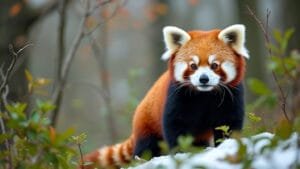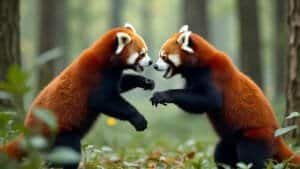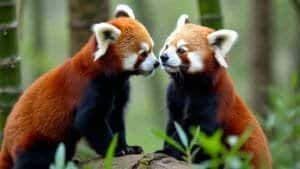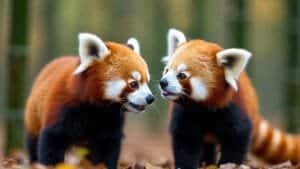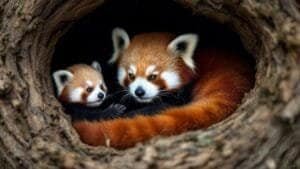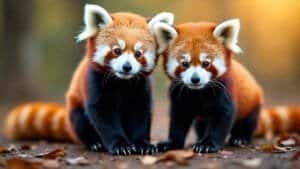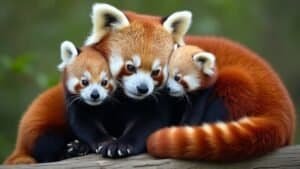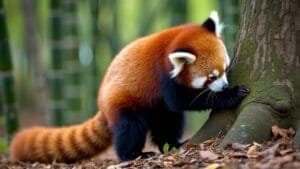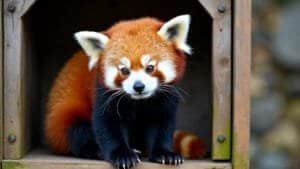The birthing process of red pandas is a fascinating journey that begins with a unique gestation period influenced by delayed implantation. Female red pandas carefully select nesting sites in tree hollows or rock crevices, preparing a soft, insulated space for their cubs. Typically, a litter consists of one to four cubs, born blind and helpless, weighing only a few ounces. In the first weeks, the mother dedicates most of her time to caring for her young, keeping them hidden from predators and frequently moving them between nests
As the cubs grow, they experience significant developmental milestones, such as opening their eyes around day 18, transitioning to solid food at about three months, and gaining full independence by eight months. This article explores every stage of the red panda birthing process, from reproduction and gestation to cub development and independence, providing an in-depth look at the maternal instincts and survival strategies of these remarkable animals
Red Panda Reproduction and Gestation
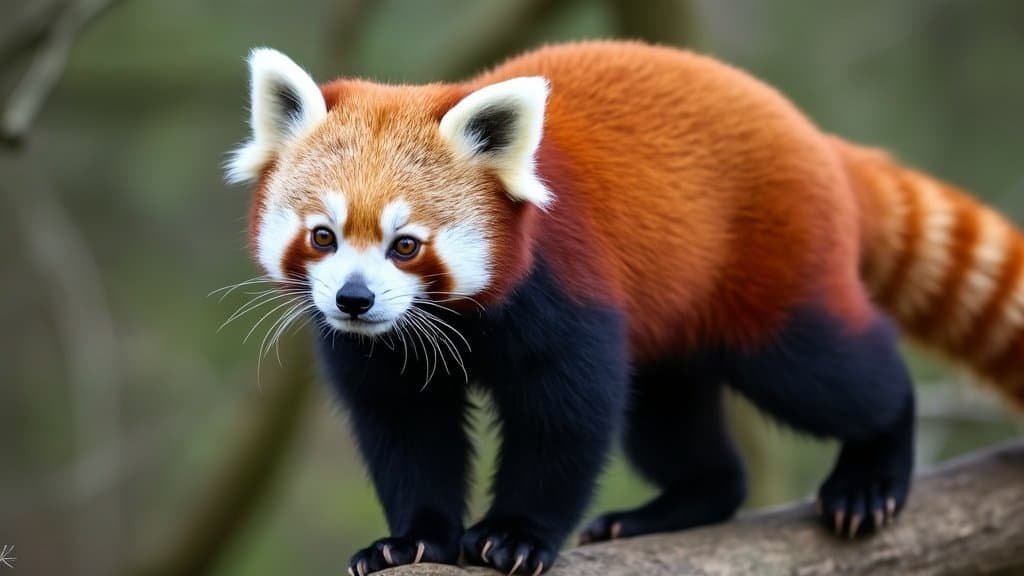
Red pandas have a unique reproductive cycle that aligns with seasonal environmental conditions. Their mating behaviors, gestation period, and nesting habits all contribute to the survival of their cubs. Understanding these aspects provides insight into the challenges these animals face in the wild and in conservation efforts
Breeding Season and Mating Behavior
Red pandas have a seasonal breeding cycle that is closely tied to temperature and daylight changes. In the Northern Hemisphere, mating occurs between January and March, while in the Southern Hemisphere, it happens between June and August. This timing ensures that cubs are born during the warmer months, increasing their chances of survival
During the breeding season, red pandas become more active, and males engage in scent-marking behaviors to communicate their presence to females. They secrete pheromones from scent glands located near their tails and rub them on trees and rocks. Both males and females also use urine marking as a way to signal reproductive readiness. Unlike some other mammals, red pandas do not form long-term pair bonds. Instead, a female may mate with multiple males, and males compete for access to receptive females
Courtship behaviors involve gentle vocalizations, including high-pitched whistles and twitters. Mating takes place on the ground or in trees, and encounters are brief, lasting only a few minutes. After mating, males do not participate in raising the offspring, leaving the mother solely responsible for the cubs’ care
The Unique Gestation Period of Red Pandas
One of the most fascinating aspects of red panda reproduction is delayed implantation, a reproductive strategy also seen in some other mammals like bears and weasels. After fertilization, the embryo does not immediately implant into the uterus. Instead, it remains in a dormant state for several weeks. This allows the mother to give birth at the most favorable time of the year, usually between May and July when food is more abundant
Due to delayed implantation, the total gestation period can range from 93 to 162 days, but actual embryonic development lasts around 50 days after implantation. This variability makes it difficult to predict exact birth dates, even in managed care environments. Scientists studying red pandas in captivity have confirmed that temperature and daylight play key roles in regulating the timing of implantation and birth
As the pregnancy progresses, the female becomes less active and starts preparing a nesting site where she will give birth. She also increases her food intake to store fat reserves, which are essential for milk production during the early weeks of cub-rearing
Nesting Habits Before Birth
A few days before giving birth, the female red panda begins searching for a safe and well-insulated den. In the wild, she typically chooses hollow trees, rock crevices, or dense thickets, while in captivity, she may use nesting boxes provided by zookeepers. The den must be secure, hidden from predators, and protected from harsh weather conditions
Once she selects a location, she gathers soft materials such as leaves, grass, and moss to line the nest, creating a warm and comfortable space for her cubs. This nesting behavior is crucial because red panda cubs are born blind and helpless, requiring a stable environment to develop properly
Mothers often prepare multiple nest sites and may move their cubs between them during the first few weeks after birth. This behavior helps reduce the risk of predators discovering the litter and keeps the nest clean. In captivity, this instinctive nesting behavior is still observed, with females relocating their cubs even when there is no immediate threat
For those interested in a deeper understanding of how red pandas care for their young, the San Diego Zoo’s fact sheet on red panda reproduction provides additional insights into their breeding habits and maternal care strategies
The Birth and Early Life of Red Panda Cubs
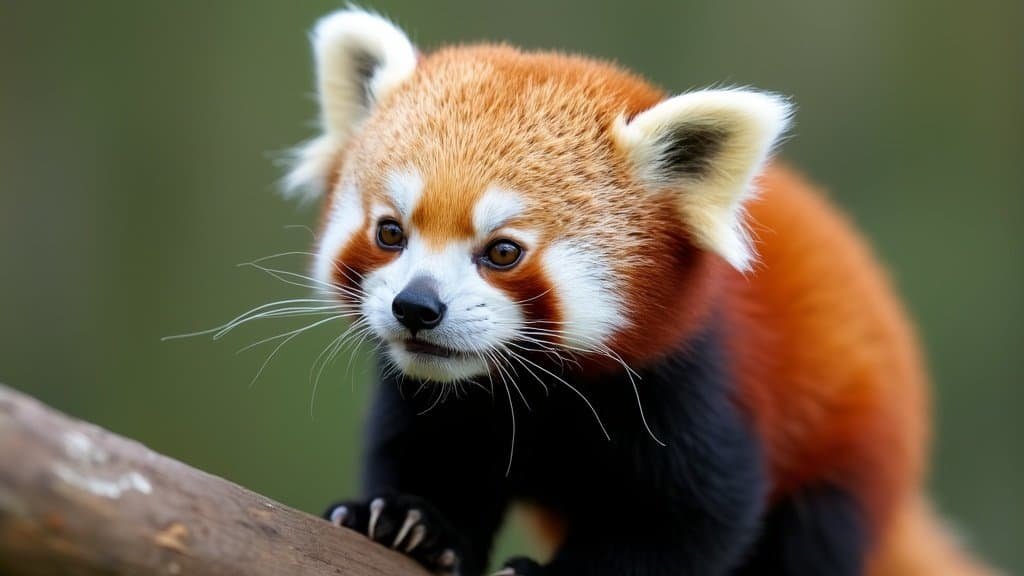
Red panda cubs enter the world in a fragile state, requiring constant care from their mother to ensure survival. Their early days are characterized by rapid development, though they remain highly dependent on maternal protection. Understanding the birth process, cub characteristics, and early development sheds light on the challenges these small mammals face in their first few months
Litter Size and Birth Characteristics
Red pandas typically give birth to one to four cubs per litter, though one or two cubs is the most common outcome. The number of cubs is influenced by factors such as the mother’s age, health, environmental conditions, and food availability. In captivity, where conditions are more stable, smaller litters are more frequent due to optimal nutrition and lower stress levels
At birth, red panda cubs are blind, deaf, and covered in thick grayish-brown fur. They weigh between 3.9 and 4.6 ounces (110 to 130 grams), roughly the size of a small apple. Their bodies are short and plump, and their limbs are not yet strong enough for mobility. Unlike adult red pandas, newborns have uniformly colored fur, lacking the distinctive reddish-orange coat that will develop as they grow
Their initial vulnerability means they rely entirely on their mother for warmth, feeding, and protection. To keep them safe, the mother stays with her cubs inside the nest for extended periods, only leaving briefly to forage for food
When Do Red Panda Cubs Open Their Eyes?
Like many other small carnivores, red panda cubs are born with their eyes closed. They rely on their sense of touch and smell to locate their mother and nest surroundings. Their eyes begin to open between 18 and 25 days after birth, though full vision development takes several more weeks. By 30 days of age, most cubs have their eyes fully open, but they still remain inside the den, as they are not yet strong enough to explore the outside world
During this time, cubs also start responding to external stimuli, including their mother’s vocalizations and gentle nudges. They communicate using soft squeaks and whimpers, which help them signal hunger or distress. As their senses improve, they become more interactive with their mother and siblings
Early Development and Maternal Care
Maternal care is essential for red panda cub survival. The mother spends the majority of her time in the nest during the first few weeks, leaving only to eat or briefly stretch. She provides warmth by curling around her cubs, as they are unable to regulate their body temperature effectively
The mother also stimulates urination and defecation by licking the cubs’ anogenital area, a behavior seen in many carnivorous mammals. To maintain nest hygiene, she consumes the waste, reducing odors that could attract predators. This instinct remains even in captivity, where there are no natural predators
A notable behavior of red panda mothers is nest relocation. In the wild, females often move their cubs between multiple den sites, a strategy that helps minimize the risk of predation and maintain nest cleanliness. Even in zoos, where external threats are minimal, red panda mothers frequently carry their cubs to different areas, demonstrating how deeply ingrained this survival instinct is
By the time cubs reach 50 days old, they start developing their characteristic reddish-brown fur, replacing the dull gray coat they had at birth. Around the same time, they begin attempting small movements within the nest, such as stretching and weakly crawling. However, they will not venture outside until they are at least two to three months old
For an engaging look at red panda maternal behaviors, the Red Panda Network article on red panda mothers highlights the dedication and instincts these animals exhibit in raising their young
Growth, Weaning, and Independence
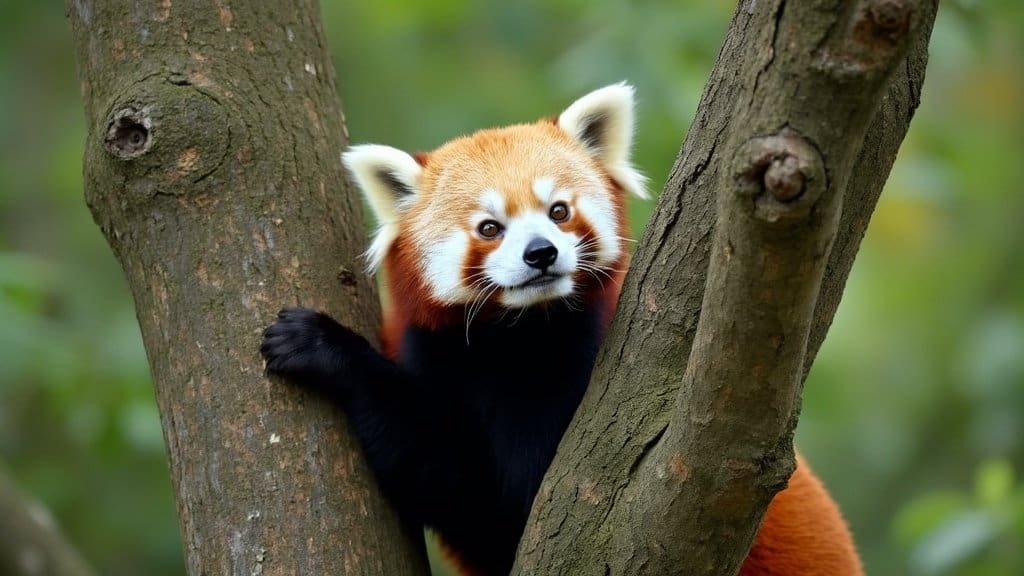
As red panda cubs grow, they transition from a diet of their mother’s milk to solid foods, gaining independence over time. This process involves key developmental milestones, including exploring their surroundings, learning survival skills, and eventually separating from their mother to lead solitary lives. Understanding this phase provides insight into their survival in the wild and in conservation settings
Transitioning to Solid Food and Weaning
Red panda cubs begin chewing on bamboo twigs and other solid food around 50 to 60 days old, although they continue to rely on their mother’s milk for nourishment. By 90 days of age, solid food becomes a regular part of their diet, and their digestive system starts adapting to processing bamboo, which makes up the majority of an adult red panda’s diet
Unlike giant pandas, which primarily consume bamboo, red pandas have a more varied diet that includes fruits, berries, mushrooms, and even small insects. In captivity, young red pandas are introduced to a mix of bamboo, fruits, and specialized nutritional biscuits to ensure a balanced diet
Weaning occurs gradually between 13 and 22 weeks (around three to five months). During this period, cubs continue to nurse but rely more on solid food. By the time they are completely weaned, their milk teeth have been replaced by stronger adult teeth, enabling them to efficiently chew tougher plant materials
How Long Do Cubs Stay With Their Mother?
Red panda cubs remain under their mother’s care for about eight months, during which they learn essential survival skills. These include:
Climbing proficiency: Cubs practice climbing trees and rocky surfaces to escape predators and find food
Foraging techniques: The mother demonstrates how to strip bamboo leaves and locate other food sources
Social interactions: Cubs communicate through soft whistles, twitters, and body language, developing the communication skills they will use as adults
During this time, cubs become more independent but still sleep in the same nest as their mother. By six months, they begin spending more time outside the den, exploring their surroundings and strengthening their muscles for climbing
When Do Red Pandas Become Fully Independent?
By eight to ten months, red panda cubs become fully independent. In the wild, they begin establishing their own territories, while in captivity, they are often separated from their mother to prevent conflicts. Red pandas are naturally solitary animals, and even siblings do not typically remain together once they reach adulthood
Sexual maturity occurs between 18 and 20 months, but red pandas do not typically breed until they are two years old. Once independent, they live solitary lives, only interacting with others during the mating season
For a detailed exploration of red panda life stages, Sarah Lyn Gay’s article on the red panda life cycle offers further insights into how these animals develop from birth to adulthood


